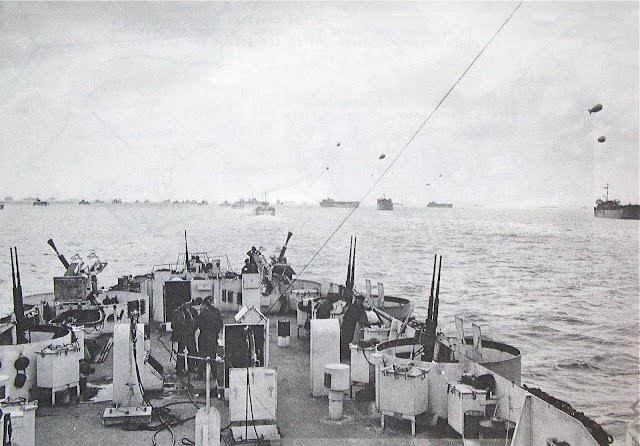OVERLORD, D-DAY
OPERATION NEPTUNE, June 6, 1944
By Clayton Marks, RCNVR and Combined Operations
Landing craft, manned by Canadians and filled with troops, are lowered
from the Prince David. Photo Credit - Imperial War Museum
OPERATION NEPTUNE, June 6, 1944 - Part 3
Canadian troop ships, i.e., Prince Henry and Prince David, carrying hundreds of assault troops (members of the Canadian Scottish Regiment and Regiment de la Chaudiere, and others), began their channel-crossing later in the evening. Algonquin and Sioux, bombardment destroyers in Force J, were bound as well for Sword, Juno and Gold sectors in the British area. Group by group, "moving at set speeds", including the 264th Canadian Flotilla attached to Force G, took up their formations.
All manner of ships, i.e., warships, transports, special craft of every kind, arranged themselves in such a way to arrive at the right place at the right time off the beaches. Groups looked like individual convoys, "each separated by exact intervals from the one behind and the one ahead." Escort ships drew alongside them, and the whole assembly - in ten great streams - moved toward mid-channel positions.
After 2200 a brisk wind was noted and by midnight a full moon was overhead the endless series of wakes produced by what seemed countless ships pointing "southward toward Baie de la Seine", all under orders not to fire upon passing planes which were "almost certain to be friendly". Bombers bound for the enemy coast were overhead and an hour later would come transports and troop-carrying gliders "towed in long trains", with the men of the parachute divisions.
The advance some ships overtook others as they moved into their final stations and some elbowed aside returning mine-sweepers. Dimly outlined in the pre-dawn darkness, U.S. battleships, British and French cruisers (Glasgow, Montcalm, Georges Leygues), and Canadian ships could be seen among the hundreds moving into prescribed positions.
Prince Henry and Prince David emerged from their respective channels and positioned themselves seven miles off shore in Juno sector. Each turned "parallel to the coast", as did the ships that followed them, and by 5:35 AM nineteen vessels were safely at anchor.
As daylight appeared, many other ships exited their swept channels and could be seen along the coast for many miles. Returning bombers were heard overhead, and in places "the shoreline glowed and smoked", revealing that bombs had left their mark. Soon there was an enormous roar overhead of the anchored landing ships. The "first salvoes of battleships and cruisers" screamed on their way to prescribed targets on shore.
Immediately thereafter landing ships sprang into action. The crews of assault craft on Prince Henry and Prince David took to their stations. Waiting soldiers below decks checked their gear one last time and listened for hardened commands from loud hailers overhead:
"Will move in... five... minutes"....
"Will move.... now".
Disembarking from troop ships. Photos as found in Combined Operations
Royal Marines "went over the side" first from Prince David to provide small-arms fire, and were followed by other Marines responsible for "clearing mines and obstacles ahead of the assault craft."
Then came the Canadians! Soldiers climbed quietly into flat-bottomed assault craft and were lowered over the sides of Prince Henry and Prince David. Two Canadian flotillas joined the mass of LCAs from other landing ships nearby. Immediately after groups formed, a motor gunboat at the lead, they began the seven-mile trip to shore. Flights and forces became "one vast inward movement" on its way toward the Baie de la Seine's 20-mile-wide shore.
H-hour, or touch-down time for the Eastern Tank Force, was set for 07:25 in Sword and Gold sectors; and was about thirty minutes later in Juno sector so that off-shore rocks could be covered by the incoming tide. LCA's would reach the beaches in an hour, travelling steadily while salvoes screamed overhead - "to be completed by the time they arrived."
Some LCAs, crew members and soldiers did not arrive ashore without hardship, others "were mentioned in dispatches for their bravery during the landings." As well, turbulence interfered "the launching plans for the amphibious tanks" but still, up and down the coastline "the movement was proceeding... with uncanny precision." Destroyers and support craft closely engaged beach defenses and Army artillery fired as it came.
Fleet class destroyers opened fire, HMCS Algonquin and Sioux among them. Though dust from earlier air bombardments still obscured assigned targets, several of Algonquins salvoes fell directly on them and she then targeted "a row of houses sheltering snipers along Nan Red." Sioux silenced guns inside two large buildings, and later checked her fire to allow landing craft to approach shore.
Projectiles from "the terrible rocket-firing ships" hurtled inland "with a searing roar" and blasted anything in their way. Next came craft which went ashore to deposit Avre tanks of the Royal Engineers, tasked to "breach minefields and concrete barriers in the paths of the troops."
Still other craft - some under German fire - followed the Avres to drop the men responsible for clearing away mines and beach obstructions, all of which presented significant challenges, because the German-made reefs lined beaches for half a mile off shore.
For example, heavy steel gates, eight feet wide by ten feet high, projected from the bottom on Sword and Gold beaches. They directed landing craft onto obstructions behind them. On all beaches landing craft had to face many lines of sharp wooden stakes projecting from the sand, and behind the stakes stood an army of steel-pronged tripods capable of ripping the bottom of many vessels to shreds. "Many of the tripods were mined" and all manner of mines were found in the sand and upon concrete pyramids assembled to delay and destroy Allied forces.
Field Marshal Erwin Rommel inspecting Atlantic Wall defences, April 1944
Photo credit - Juno Beach at Wikipedia
Please link to Story: Overlord - Operation Neptune, D-Day - Part 2


























